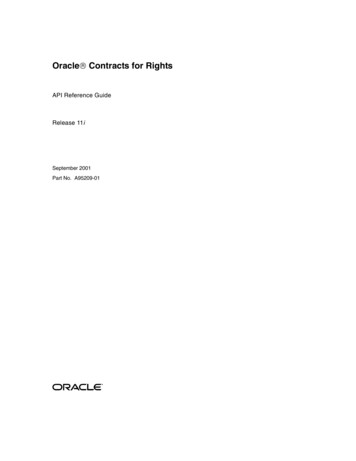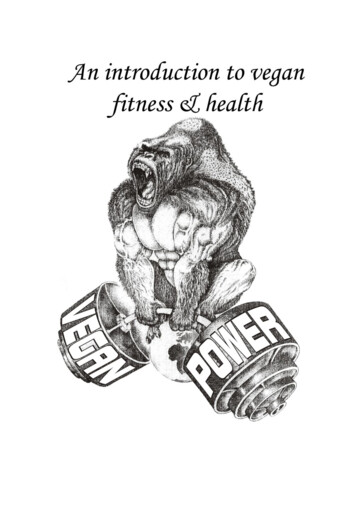
Transcription
The vegan PackageSeptember 26, 2005Title Community Ecology PackageVersion 1.6-10Date September 26, 2005Author Jari Oksanen, Roeland Kindt, Bob O’HaraMaintainer Jari Oksanen jari.oksanen@oulu.fi Description Ordination methods and other useful functions for community and vegetation ecologists.License GPL2URL http://cc.oulu.fi/ jarioksa/R topics documented:BCI . . . . . . . .anosim . . . . . . .anova.cca . . . . .bioenv . . . . . . .capscale . . . . . .cca . . . . . . . . .cca.object . . . . .decorana . . . . . .decostand . . . . .deviance.cca . . . .distconnected . . .diversity . . . . . .dune . . . . . . . .envfit . . . . . . .fisherfit . . . . . .goodness.cca . . .goodness.metaMDShumpfit . . . . . .linestack . . . . . .make.cepnames . .mantel . . . . . . .metaMDS . . . . .ordihull . . . . . .ordiplot . . . . . .1.2356810131619212224262730333536394041424648
2BCIordiplot3d . .ordisurf . . .orditorp . . .plot.cca . . .predict.cca . .procrustes . .radfit . . . . .rankindex . .read.cep . . .scores . . . .specaccum . .specpool . . .stepacross . .varespec . . .vegan-internalvegdist . . . .vegemite . . .wascores . . rro Colorado Island Tree CountsDescriptionTree counts in 1-hectare plots in the Barro Colorado Island.Usagedata(BCI)FormatA data frame with 50 plots (rows) of 1 hectare with counts of trees on each plot with total of 225species (columns). Full Latin names are used for tree species.DetailsData give the numbers of trees at least 10 cm in diameter at breast height (1.3 m above the ground)in each one hectare square of forest. Within each one hectare square, all individuals of all specieswere tallied and are recorded in this table.The data frame contains only the Barro Colorado Island subset of the original ull/295/5555/666/DC1ReferencesCondit, R, Pitman, N, Leigh, E.G., Chave, J., Terborgh, J., Foster, R.B., Nuñez, P., Aguilar, S.,Valencia, R., Villa, G., Muller-Landau, H.C., Losos, E. & Hubbell, S.P. (2002). Beta-diversity intropical forest trees. Science 295, 666–669.
3anosimExamplesdata(BCI)anosimAnalysis of SimilaritiesDescriptionAnalysis of similarities (ANOSIM) provides a way to test statistically whether there is a significantdifference between two or more groups of sampling units.Usageanosim(dis, grouping, permutations 1000, strata)ArgumentsdisDissimilarity matrix.groupingFactor for grouping observations.permutations Number of permutation to assess the significance of the ANOSIM statistic.strataAn integer vector or factor specifying the strata for permutation. If supplied,observations are permuted only within the specified strata.DetailsAnalysis of similarities (ANOSIM) provides a way to test statistically whether there is a significantdifference between two or more groups of sampling units. Function anosim operates directly on adissimilarity matrix. A suitable dissimilarity matrix is produced by functions dist or vegdist.The method is philosophically allied with NMDS ordination (isoMDS), in that it uses only the rankorder of dissimilarity values.If two groups of sampling units are really different in their species composition, then compositionaldissimilarities between the groups ought to be greater than those within the groups. The anosimstatistic R is based on the difference of mean ranks between groups (rB ) and within groups (rW ):R (rB rW )/(N (N 1)/4)The divisor is chosen so that R will be in the interval 1 . . . 1, value 0 indicating completelyrandom grouping.The statistical significance of observed R is assessed by permuting the grouping vector to obtainthe empirical distribution of R under null-model.The function has summary and plot methods. These both show valuable information to assessthe validity of the method: The function assumes that all ranked dissimilarities within groups haveabout equal median and range. The plot method uses boxplot with options notch TRUE andvarwidth TRUE.
4anosimValueThe function returs a list of class anosim with following items:callFunction call.statisticThe value of ANOSIM statistic RsignifSignificance from permutation.permPermutation values of Rclass.vecFactor with value Between for dissimilarities between classes and class namefor corresponding dissimilarity within class.dis.rankRank of dissimilarity entry.dissimilarityThe name of the dissimilarity index: the "method" entry of the dist object.NoteI don’t quite trust this method. Somebody should study its performance carefully. The functionreturns a lot of information to ease further scrutiny.Author(s)Jari Oksanen, with a help from Peter R. Minchin.ReferencesClarke, K. R. (1993). Non-parametric multivariate analysis of changes in community structure.Australian Journal of Ecology 18, 117-143.See Alsodist and vegdist for obtaining dissimilarities, and rank for ranking real values. For comparingdissimilarities against continuous variables, see mantel.Examplesdata(dune)data(dune.env)dune.dist - vegdist(dune)attach(dune.env)dune.ano - anosim(dune.dist, Management)summary(dune.ano)plot(dune.ano)
5anova.ccaanova.ccaPermutation Test for Constrained Correspondence Analysis, Redundancy Analysis and Constrained Analysis of Principal CoordinatesDescriptionThe function performs an ANOVA like permutation test for Constrained Correspondence Analysis(cca), Redundancy Analysis (rda) or Constrained Analysis of Principal Coordinates (capscale)to assess the significance of constraints.Usage## S3 method for class 'cca':anova(object, alpha 0.05, beta 0.01, step 100, perm.max 10000, .)permutest.cca(x, permutations 100, model c("direct", "reduced","full"), strata)Argumentsobject,xA result object from cca.alphaTargeted Type I error rate.betaAccepted Type II error rate.stepNumber of permutations during one step.perm.maxMaximum number of permutations.Parameters to permutest.cca.permutations Number of permutations for assessing significance of constraints.modelPermutation model (partial match).strataAn integer vector or factor specifying the strata for permutation. If supplied,observations are permuted only within the specified strata.DetailsFunctions anova.cca and permutest.cca implement an ANOVA like permutation test for thejoint effect of constraints in cca, rda or capscale. Functions anova.cca and permutest.ccadiffer in printout style and in interface. Function permutest.cca is the proper workhorse, butanova.cca passes all parameters to permutest.cca.In anova.cca the number of permutations is controlled by targeted “critical” P value (alpha)and accepted Type II or rejection error (beta). If the results of permutations differ from the targetedalpha at risk level given by beta, the permutations are terminated. If the current estimate ofP does not differ significantly from alpha of the alternative hypothesis, the permutations arecontinued with step new permutations.The function permutest.cca implements a permutation test for the “significance” of constraintsin cca, rda or capscale. Community data are permuted with choice model "direct",residuals after partial CCA/RDA/CAP with choice model "reduced", and residuals afterCCA/RDA/CAP under choice model "full". If there is no partial CCA/RDA/CAP stage,model "reduced" simply permutes the data. The test statistic is “pseudo-F ”, which is theratio of constrained and unconstrained total Inertia (Chi-squares, variances or something similar),each divided by their respective ranks. If there are no conditions ("partial" terms), the sum of alleigenvalues remains constant, so that pseudo-F and eigenvalues would give equal results. In partial
6bioenvCCA/RDA/CAP, the effect of conditioning variables (“covariables”) is removed before permutation,and these residuals are added to the non-permuted fitted values of partial CCA (fitted values of X Z). Consequently, the total Chi-square is not fixed, and test based on pseudo-F would differfrom the test based on plain eigenvalues. CCA is a weighted method, and environmental data arere-weighted at each permutation step.ValueFunction permutest.cca returns an object of class permutest.cca which has its own printmethod. The function anova.cca calls permutest.cca, fills an anova table and uses print.anovafor printing.Author(s)Jari OksanenReferencesLegendre, P. and Legendre, L. (1998). Numerical Ecology. 2nd English ed. Elsevier.See Alsocca, rda, cca - cca(varespec Al P K, varechem)anova(vare.cca)permutest.cca(vare.cca)## Test for adding variable N to the previous model:anova(cca(varespec N Condition(Al P K), varechem), step 40)bioenvBest Subset of Environmental Variables with Maximum (Rank) Correlation with Community DissimilaritiesDescriptionFunction finds the best subset of environmental variables, so that the Euclidean distances of scaledenvironmental variables have the maximum (rank) correlation with community dissimilarities.Usage## Default S3 method:bioenv(comm, env, method "spearman", index "bray",upto ncol(env), .)## S3 method for class 'formula':bioenv(formula, data, .)
7bioenvArgumentscommCommunity data frame.envData frame of continuous environmental variables.methodThe correlation method used in cor.test.indexThe dissimilarity index used for community data in vegdist.uptoMaximum number of parameters in studied subsets.formula, dataModel formula and data.Other parameters passed to function.DetailsThe function calculates a community dissimilarity matrix using vegdist. Then it selects all possible subsets of environmental variables, scales the variables, and calculates Euclidean distancesfor this subset using dist. Then it finds the correlation between community dissimilarities andenvironmental distances, and for each size of subsets, saves the best result. There are 2p 1 subsetsof p variables, and exhaustive search may take a very, very, very long time (parameter upto offersa partial relief).The function can be called with a model formula where the LHS is the data matrix and RHSlists the environmental variables. The formula interface is practical in selecting or transformingenvironmental variables.Clarke & Ainsworth (1993) suggested this method to be used for selecting the best subset of environmental variables in interpreting results of nonmetric multidimensional scaling (NMDS). Theyrecommended a parallel display of NMDS of community dissimilarities and NMDS of Euclideandistances from the best subset of scaled environmental variables. They warned against the use ofProcrustes analysis, but to me this looks like a good way of comparing these two ordinations.Clarke & Ainsworth wrote a computer program BIO-ENV giving the name to the current function.Presumably BIO-ENV was later incorporated in Clarke’s PRIMER software (available for Windows). In addition, Clarke & Ainsworth suggested a novel method of rank correlation which is notavailable in the current function.ValueThe function returns an object of class bioenv with a summary method.Author(s)Jari Oksanen. The code for selecting all possible subsets was posted to the R mailing list by Prof.B. D. Ripley in 1999.ReferencesClarke, K. R & Ainsworth, M. 1993. A method of linking multivariate community structure toenvironmental variables. Marine Ecology Progress Series, 92, 205–219.See Alsovegdist, dist, cor for underlying routines, isoMDS for ordination, procrustes for Procrustes analysis, protest for an alternative, and rankindex for studying alternatives to thedefault Bray-Curtis index.
8capscaleExamples# The method is very slow for large number of possible subsets.# Therefore only 6 variables in this example.data(varespec)data(varechem)sol - bioenv(wisconsin(varespec) log(N) P K Ca pH Al, varechem)solsummary(sol)capscale[Partial] Constrained Analysis of Principal CoordinatesDescriptionConstrained Analysis of Principal Coordinates (CAP) is an ordination method similar to Redundancy Analysis (rda), but it allows non-Euclidean dissimilarity indices, such as Manhattan orBray–Curtis distance. Despite this non-Euclidean feature, the analysis is strictly linear and metric.If called with Euclidean distance, the results are identical to rda, but capscale will be muchmore inefficient. Function capscale may be useful with other dissimilarity measures, since Euclidean distances inherent in rda are generally poor with community dataUsagecapscale(formula, data, distance "euclidean", comm NULL, add FALSE, .)ArgumentsformulaModel formula. The function can be called only with the formula interface.Most usual features of formula hold, especially as defined in cca and rda.The LHS must be either a community data matrix or a dissimilarity matrix, e.g.,from vegdist or dist. If the LHS is a data matrix, function vegdist willbe used to find the dissimilarities. RHS defines the constraints. The constraintscan be continuous or factors, they can be transformed within the formula, andthey can have interactions as in typical formula. The RHS can have a specialterm Condition that defines variables “partialled out” before constraints, justlike in rda or cca. This allows the use of partial CAP.dataData frame containing the variables on the right hand side of the model formula.distanceDissimilarity (or distance) index in vegdist used if the LHS of the formulais a data frame instead of dissimilarity matrix.commCommunity data frame which will be used for finding species scores when theLHS of the formula was a dissimilarity matrix. This is not used if the LHS isa data frame. If this is not supplied, the “species scores” are the axes of initialmetric scaling (cmdscale) and may be confusing.addlogical indicating if an additive constant should be computed, and added to thenon-diagonal dissimilarities such that all eigenvalues are non-negative in underlying Principal Co-ordinates Analysis (see cmdscale for details).Other parameters passed to rda.
capscale9DetailsThe Canonical Analysis of Principal Coordinates (CAP) is simply a Redundancy Analysis of resultsof Metric (Classical) Multidimensional Scaling (Anderson & Willis 2003). Function capscale usestwo steps: (1) it ordinates the dissimilarity matrix using cmdscale and (2) analyses these resultsusing rda. If the user supplied a community data frame instead of dissimilarities, the functionwill find the needed dissimilarity matrix using vegdist with specified distance. However, themethod will accept dissimilarity matrices from vegdist, dist, or any other method producingsimilar matrices. The constraining variables can be continuous or factors or both, they can haveinteraction terms, or they can be transformed in the call. Moreover, there can be a special termCondition just like in rda and cca so that “partial” CAP can be performed.The current implementation differs from the method suggested by Anderson & Willis (2003) inthree major points:1. Anderson & Willis used orthonormal solution of cmdscale, whereas capscale uses axesweighted by corresponding eigenvalues, so that the ordination distances are best approximations of original dissimilarities. In the original method, later “noise” axes are just as importantas first major axes.2. Anderson & Willis take only a subset of axes, whereas capscale uses all axes with positiveeigenvalues. The use of subset is necessary with orthonormal axes to chop off some “noise”,but the use of all axes guarantees that the results are the best approximation of original dissimilarities.3. Function capscale adds species scores as weighted sums of (residual) community matrix (ifthe matrix is available), whereas Anderson & Willis have no fixed method for adding speciesscores.With these definitions, function capscale with Euclidean distances will be identical to rda ineigenvalues and in site, species and biplot scores (except for possible sign reversal). However, itmakes no sense to use capscale with Euclidean distances, since direct use of rda is much moreefficient. Even with non-Euclidean dissimilarities, the rest of the analysis will be metric and linear.ValueThe function returns an object of class capscale which is identical to the result of rda. At themoment, capscale does not have specific methods, but it uses cca and rda methods plot.cca,summary.rda etc. Moreover, you can use anova.cca for permutation tests of “significance”of the results.NoteWarnings of negative eigenvalues are issued with most dissimilarity indices. These are harmless,and negative eigenvalues will be ignored in the analysis. If the warnings are disturbing, you canuse argument add TRUE passed to cmdscale, or, preferably, a distance measure that does notcause these warnings. In vegdist, method "jaccard" gives such an index. Alternatively,after square root transformation many indices do not cause warnings.Function rda usually divides the ordination scores by number of sites minus one. In this way,the inertia is variance instead of sum of squares, and the eigenvalues sum up to variance. Manydissimilarity measures are in the range 0 to 1, so they have already made a similar division. Ifthe largest original dissimilarity is less or equal to 4 (allowing for stepacross), this divisionis undone in capscale and original dissimilarities are used. The inertia is called as squareddissimilarity (as defined in the dissimilarity matrix), but keyword mean is added to the inertiain cases where division was made, e.g. in Euclidean and Manhattan distances.
10ccaAuthor(s)Jari OksanenReferencesAnderson, M.J. & Willis, T.J. (2003). Canonical analysis of principal coordinates: a useful methodof constrained ordination for ecology. Ecology 84, 511–525.See Alsorda, cca, plot.cca, anova.cca, vegdist, dist, cap - capscale(varespec N P K Condition(Al), varechem, dist rtial] [Constrained] Correspondence Analysis and RedundancyAnalysisDescriptionFunction cca performs correspondence analysis, or optionally constrained correspondence analysis(a.k.a. canonical correspondence analysis), or optionally partial constrained correspondence analysis. Function rda performs redundancy analysis, or optionally principal components analysis.These are all very popular ordination techniques in community ecology.Usage## S3 method for class 'formula':cca(formula, data)## Default S3 method:cca(X, Y, Z, .)## S3 method for class 'formula':rda(formula, data, scale FALSE)## Default S3 method:rda(X, Y, Z, scale FALSE, .)## S3 method for class 'cca':summary(object, scaling 2, axes 6, digits, .)ArgumentsformulaModel formula, where the left hand side gives the community data matrix, righthand side gives the constraining variables, and conditioning variables can begiven within a special function Condition.dataData frame containing the variables on the right hand side of the model formula.
11ccaXCommunity data matrix.YConstraining matrix, typically of environmental variables. Can be missing.ZConditioning matrix, the effect of which is removed (‘partialled out’) beforenext step. Can be missing.objectA cca result object.scalingScaling for species and site scores. Either species (2) or site (1) scores arescaled by eigenvalues, and the other set of scores is left unscaled, or with 3 bothare scaled symmetrically by square root of eigenvalues. Correspondingnegativepvalues can be used in cca to additionally multiply results with (1/(1 λ)).This scaling is know as Hill scaling (although it has nothing to do with Hill’srescaling of decorana). With corresponding negative values inrda, speciesscores are divided by standard deviation of each species. Unscaled raw scoresstored in the result can be accessed with scaling 0.axesNumber of axes in summaries.digitsNumber of digits in output.scaleScale species to unit variance (like correlations do).Other parameters for print or plot functions.DetailsSince their introduction (ter Braak 1986), constrained or canonical correspondence analysis, andits spin-off, redundancy analysis have been the most popular ordination methods in communityecology. Functions cca and rda are similar to popular proprietary software Canoco, althoughimplementation is completely different. The functions are based on Legendre & Legendre’s (1998)algorithm: in cca Chi-square transformed data matrix is subjected to weighted linear regression onconstraining variables, and the fitted values are submitted to correspondence analysis performed viasingular value decomposition (svd). Function rda is similar, but uses ordinary, unweighted linearregression and unweighted SVD.The functions can be called either with matrix entries for community data and constraints, or withformula interface. In general, the formula interface is preferred, because it allows a better controlof the model and allows factor constraints.In matrix interface, the community data matrix X must be given, but any other data matrix can beomitted, and the corresponding stage of analysis is skipped. If matrix Z is supplied, its effects areremoved from the community matrix, and the residual matrix is submitted to the next stage. Thisis called ‘partial’ correspondence or redundancy analysis. If matrix Y is supplied, it is used to constrain the ordination, resulting in constrained or canonical correspondence analysis, or redundancyanalysis. Finally, the residual is submitted to ordinary correspondence analysis (or principal components analysis). If both matrices Z and Y are missing, the data matrix is analysed by ordinarycorrespondence analysis (or principal components analysis).Instead of separate matrices, the model can be defined using a model formula. The left handside must be the community data matrix (X). The right hand side defines the constraining model.The constraints can contain ordered or unordered factors, interactions among variables and functions of variables. The defined contrasts are honoured in factor variables. The formulacan include a special term Condition for conditioning variables (“covariables”) “partialled out”before analysis. So the following commands are equivalent: cca(X, y, z), cca(X y Condition(z)), where y and z refer to single variable constraints and conditions.Constrained correspondence analysis is indeed a constrained method: CCA does not try to displayall variation in the data, but only the part that can be explained by the used constraints. Consequently, the results are strongly dependent on the set of constraints and their transformations or
12ccainteractions among the constraints. The shotgun method is to use all environmental variables as constraints. However, such exploratory problems are better analysed with unconstrained methods suchas correspondence analysis (decorana, ca) or non-metric multidimensional scaling (isoMDS)and environmental interpretation after analysis (envfit, ordisurf). CCA is a good choice ifthe user has clear and strong a priori hypotheses on constraints and is not interested in the majorstructure in the data set.CCA is able to correct a common curve artefact in correspondence analysis by forcing the configuration into linear constraints. However, the curve artefact can be avoided only with a low numberof constraints that do not have a curvilinear relation with each other. The curve can reappear evenwith two badly chosen constraints or a single factor. Although the formula interface makes easy toinclude polynomial or interaction terms, such terms often allow curve artefact (and are difficult tointerpret), and should probably be avoided.According to folklore, rda should be used with “short gradients” rather than cca. However, thisis not based on research which finds methods based on Euclidean metric as uniformly weaker thanthose based on Chi-squared metric.Partial CCA (pCCA; or alternatively partial RDA) can be used to remove the effect of some conditioning or “background” or “random” variables or “covariables” before CCA proper. In fact, pCCAcompares models cca(X z) and cca(X y z) and attributes their difference to the effect of y cleansed of the effect of z. Some people have used the method for extracting “componentsof variance” in CCA. However, if the effect of variables together is stronger than sum of both separately, this can increase total Chi-square after “partialling out” some variation, and give negative“components of variance”. In general, such components of “variance” are not to be trusted due tointeractions between two sets of variables.The functions have summary and plot methods. The summary method lists all species andsite scores, and results may be very long. Palmer (1993) suggested using linear constraints (“LCscores”) in ordination diagrams, because these gave better results in simulations and site scores(“WA scores”) are a step from constrained to unconstrained analysis. However, McCune (1997)showed that noisy environmental variables (and all environmental measurements are noisy) destroy“LC scores” whereas “WA scores” were little affected. Therefore the plot function uses site scores(“WA scores”) as the default. This is consistent with the usage in statistics and other functions in R(lda, cancor).ValueFunction cca returns a huge object of class cca, which is described separately in cca.object.Function rda returns an object of class rda which inherits from class cca and is described incca.object. The scaling used in rda scores is desribed in a separate vignette with this package.Author(s)The responsible author was Jari Oksanen, but the code borrows heavily from Dave Roberts (http://labdsv.nr.usu.edu/).ReferencesThe original method was by ter Braak, but the current implementations follows Legendre and Legendre.Legendre, P. and Legendre, L. (1998) Numerical Ecology. 2nd English ed. Elsevier.McCune, B. (1997) Influence of noisy environmental data on canonical correspondence analysis.Ecology 78, 2617-2623.
13cca.objectPalmer, M. W. (1993) Putting things in even better order: The advantages of canonical correspondence analysis. Ecology 74, 2215-2230.Ter Braak, C. J. F. (1986) Canonical Correspondence Analysis: a new eigenvector technique formultivariate direct gradient analysis. Ecology 67, 1167-1179.See AlsoThere is a special documentation for plot.cca function with its helper functions (text.cca,points.cca, scores.cca). Function anova.cca provides an ANOVA like permutationtest for the “significance” of constraints. Automatic model building (dangerous!) is discussed indeviance.cca. Diagnostic tools, prediction and adding new points in ordination are discussedin goodness.cca and predict.cca. Functions CAIV (library CoCoAn) and cca (libraryade4) provide alternative implementations of CCA (these are internally quite different). Functioncapscale is a non-Euclidean generalization of rda.Examplesdata(varespec)data(varechem)## Common but bad way: use all variables you happen to have in your## environmental data matrixvare.cca - cca(varespec, varechem)vare.ccaplot(vare.cca)## Formula interface and a better modelvare.cca - cca(varespec Al P*(K Baresoil), data varechem)vare.ccaplot(vare.cca)## Partialling out' and negative components of variance'cca(varespec Ca, varechem)cca(varespec Ca Condition(pH), varechem)## RDAdata(dune)data(dune.env)dune.Manure - rda(dune Manure, dune.env)plot(dune.Manure)cca.objectResult Object from Constrained Ordination with cca, rda or capscaleDescriptionOrdination methods cca, rda and capscale return similar result objects. Function capscaleinherits from rda and rda inherits from cca. This inheritance structure is due to historic reasons: cca was the first of these implemented in vegan. Hence the nomenclature in cca.objectreflects cca. This help page describes the internal structure of the cca object for programmers.ValueA cca object has the following elements:callfunction call.
14cca.objectcolsum, rowsumColumn and row sums in cca. In rda, item colsum contains standard deviations of species and rowsum is NA.grand.totalGrand total of community data in cca and NA in rda.inertiaText used as the name of inertia.methodText used as the name of the ordination method.termsThe terms component of the formula. This is missing if the ordination wasnot called with formula.terminfoFurther information on terms with three subitems: terms which is like theterms component above, but lists conditions and constrainst similarly; xl
plot(dune.ano) anova.cca 5 anova.cca Permutation Test for Constrained Correspondence Analysis, Redun-dancy Analysis and Constrained Analysis of Principal Coordinates Description The function performs an ANOVA like permutation test for Constrained Correspondence Analysis










